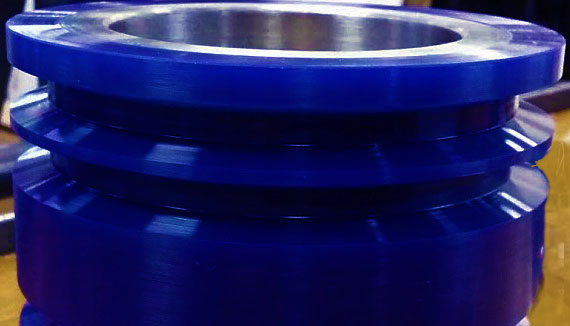When it comes to choosing the right material for your industrial roller applications, you may have a lot of questions. If your existing equipment came with rubber rollers , should you go with rubber again? Let’s take a look at polyurethane and rubber and see how they perform.
Do these materials have commonalities?
- Both are elastomers, which means that they have elastic properties.
- For acid resistance, their ratings are fair to good, whether it is diluted or concentrated.
- Resistance rating for lacquer solvents is poor for both.
- For adhering to metal cores, both are excellent.
- When you need a pattern on the outer diameter of a roller to perform a specific task, both are machinable.
What sets polyurethane apart from rubber materials?
- Durometer – Rubber can be processed in 30 Shore A to 90 Shore A. Polyurethane has a much broader range from 10 Shore “OO” to 70 Shore “D”.
- Chemical composition – Rubber is derived from sap and you can add fillers to it to change its properties, however, urethane surpasses it. There are hundreds of formulations that can be made to give you the necessary properties your application requires.
- Marring of products – Rubber has carbon added to it, that when it comes into contact with products, can leave black marks on it. Polyurethane, whether it has pigment added to it or in its natural state, does not leave a mar on any material it comes into contact with.
- Wet environments – Polyurethane outperforms rubber in applications that are either submerged or exposed to wet environments for a long period of time, where rubber would rot over time.
- Abrasion resistance – Rollers can experience a great deal of abrasion, especially when you combine dynamic loads and high friction. Polyurethane surpasses natural rubber in both of these instances.
How this translates to your application
While the above does not cover all of the similarities and differences between rubber and polyurethane, what is listed can have a significant impact on your choice of use for rollers. The differences can really add up in downtime and manpower if you are not using the best material for your specific application.
Due to the substantial chemical capabilities of polyurethane and the range of durometers, these two things alone can keep your machinery up and moving beyond rubber. Polyurethane may not be able to solve every demand for your roller application, however if you can prioritize what is most important to you, PSI Urethanes can give you a high quality urethane that can stand up to your particular specifications.
Another benefit to polyurethane is that it can be produced in a double durometer. This means cores or hubs for some of your rollers can be manufactured out of a harder duro and a softer duro can then be bonded to it and/or machined to your requirements.
Cost And Lead Time
These are obvious factors as well that will propel your choice of material. A key point to think about with tooling for rubber is that it is very expensive. These molds are made to be compressed under tons of pressure and that requires them to be capable of taking the pressure without exploding. This process will definitely require weeks of machining and then the metal has to be hardened afterward.
When it comes to polyurethane, if you can process your rollers through an open cast process, your lead time for molds is greatly improved over rubber. These molds can be machined out of aluminum and do not need a hardening process afterward.
For more information on polyurethane rollers, please read our blog post titled Understanding Urethane Rollers.



